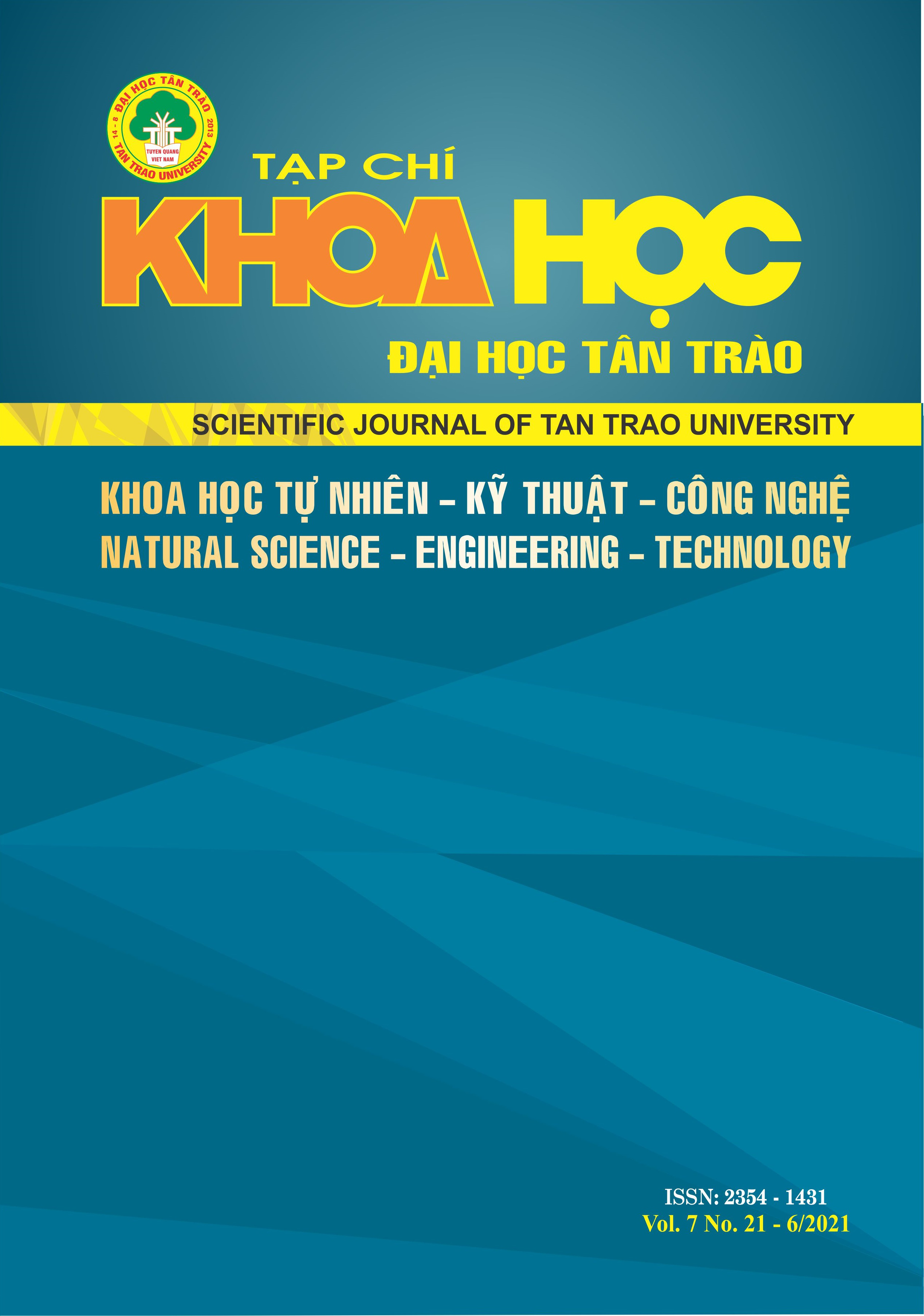CHẾ TẠO VÀ KHẢO SÁT ĐỘ DẪN ĐIỆN CỦA NANOCOMPOSITE POLYETHYLENE/GRAPHENE XỐP
DOI:
https://doi.org/10.51453/2354-1431/2021/556Từ khóa:
Äá»™ dẫn Ä‘iện, hình thái lá»— xốp, graphene, polyme nanocomposite.Tóm tắt
Nanocomposite polyme/graphene dẫn điện có tiềm năng ứng dụng rất rộng nhờ có các tính chất ưu việt như: trọng lượng nhẹ, bền hóa học, dễ chế tạo và dễ điều khiến chức năng của vật liệu. Trong nghiên cứu này, nanocompsite polyethylene/graphene và dạng xốp của nó được chế tạo và khảo sát tính chất dẫn điện. Chúng tôi đã xác định được ảnh hưởng của hàm lượng graphene tới độ dẫn điện của vật liệu cũng như tới quá trình xốp hóa của nanocomposite polyethylene/graphene. Kết quả cho thấy rằng hàm lượng graphene cũng như hình thái các lỗ xốp là các yếu tố có ảnh hưởng quan trọng tới độ dẫn điện của vật liệu.
Tải xuống
Tài liệu tham khảo
[1] Valino, A.D., Dizon, J.R.C., Espera, A.H., Chen, Q., Messman, J., Advincula, R.C. (2019). Advances in 3D printing of thermoplastic polymer composites and nanocomposites, Progress in Polymer Science, 98, 101162.
[2] Abdul Khalil, H.P.S., Fizree, H.M., Bhat, A.H., Jawaid, M., Abdullah, C.K. (2013) Development and characterization of epoxy nanocomposites based on nanostructured oil palm ash, Composites Part B: Engineering, 53: 324-333.
[3] Harfaouia, N.El., Khaaissa, Y., Nouneh, K., Belahmar, A., Talbi, A., Mabrouk, K.El., Hsissou, R., Feddi, E.M., Taleb, A., Mouakibi, A. El. (2020). One pot synthesis of silver nanoparticles on ITO surfaces: investigation of optical and electrochemical properties, The European Physical Journal Applied Physics, 91, 30401.
[4] Hsissou R., Harfi, A.El. (2020). Application of Pentaglycidyl ether Penta-ethoxy Phosphorus Composites Polymers Formulated by Two Additives, Trisodium Phosphate (TSP) and Natural Phosphate (NP) and their Combination in the Behavior of the Coating on E24 Carbon Steel in NaCl 3. 5%, 2018. [10] R. Hsissou, A. Bekhta, O. Dagdag, A. El Bachiri, M. Rafik, and A. Elharfi. Rheological properties of composite polymers and hybrid nanocomposites, Heliyon, 6, e04187.
[5] Jin., Zhao., Park. (2019). Recent Trends of Foaming in Polymer Processing: A Review; polymers, MDPI, 11, 953.
[6] Li, M.; Qiu, J.; Xing, H.; Fan, D.; Wang, S.; Li, S.; Jiang, Z.; Tang, T. (2018). In-situ cooling of adsorbed water to control cellular structure of polypropylene composite foam during CO2 batch foaming process. Polymer, 6, 155: 116–128.
[7] Tromm, M.; Shaayegan, V.; Wang, C.; Heim, H.P.; Park, C.B. (2019). Investigation of the mold-filling phenomenon in high-pressure foam injection molding and its effects on the cellular structure in expanded foams. Polymer, 160: 43–52.
[8] Balwinder S.G. (2020). Nanocomposite – review, Journal of Chemistry and Chemical Sciences.
[9] Thomassin, J. M., Pagnoulle, C., Bednarz, L., Huynen, I., Jerome, R. et al., (2008). "Foams of polycaprolactone/MWNT nanocomposites for efficient EMI reduction," J. Mater. Chem, 18: 792-796.
[10] Aghelinejad M., Leung, S.N. (2017). "Enhancement of thermoelectric conversion efficiency of polymer/carbon nanotube nanocomposites through foaming-induced microstructuring," J. Appl. Polym. Sci, 134, 45073.
[11] Peng, C., Zhang, S., Jewell, D., Chen, G.Z. (2008). Carbon nanotube and conducting polymer composites for supercapacitors, Progress in Natural Science, 18: 777-788.
[12] Gong, S., Zhu, Z.H., Li, Z. (2017). Electron tunnelling and hopping effects on the temperature coefficient of resistance of carbon nanotube/polymer nanocomposites, PCCP, 19: 5113-5120.
[13] Gong S., Zhu, Z.H. (2014). On the mechanism of piezoresistivity of carbon nanotube polymer composites, Polymer, 55: 4136-4149.
[14] Okamoto, M., Nam, P.H., Maiti, P., Kotaka, T., Nakayama, T. et al., (2001). "Biaxial Flow-Induced Alignment of Silicate Layers in Polypropylene/Clay Nanocomposite Foam," Nano Lett, 1: 503- 505.
[15] Ameli, A., Nofar, M., Park, C.B., Pötschke, P., Rizvi, G. (2014). Polypropylene/carbon nanotube nano/microcellular structures with high dielectric permittivity, low dielectric loss, and low percolation threshold, Carbon, 71: 206-217.
[16] Ding, H., Guo, Y., Leung, S.N. (2016). Development of thermally conductive polymer matrix composites by foaming-assisted networking of micron- and submicron-scale hexagonal boron nitride, J. Appl. Polym. Sci, 133.
[17] Park, D.H., Lee, Y.K., Park, S.S., Lee, C.S., Kim, S.H. et al., (2013). Effects of hybrid fillers on the electrical conductivity and EMI shielding efficiency of polypropylene/conductive filler composites, Macromolecular Research, 21: 905-910.
[18] Maiti, S., Shrivastava, N.K., Khatua, B.B. (2013). Reduction of percolation threshold through double percolation in melt-blended polycarbonate/acrylonitrile butadiene styrene/multiwall carbon nanotubes elastomer nanocomposites, Polym. Compos, 34: 570-579.
[19] Long, C.T., Li, Z.G. 7 Graphene/Polymer Composite Materials: Processing, Properties and Applications; Advanced Composite Materials: Properties and Applications.
Tải xuống
Đã Xuất bản
Cách trích dẫn
Số
Chuyên mục
Giấy phép

Tác phẩm này được cấp phép theo Giấy phép Quốc tế Creative Commons Attribution-ShareAlike 4.0 .
Bài báo được xuất bản ở Tạp chí Khoa học Đại học Tân Trào được cấp phép theo giấy phép Ghi công - Chia sẻ tương tự 4.0 Quốc tế (CC BY-SA). Theo đó, các tác giả khác có thể sao chép, chuyển đổi hay phân phối lại các bài báo này với mục đích hợp pháp trên mọi phương tiện, với điều kiện họ trích dẫn tác giả, Tạp chí Khoa học Đại học Tân Trào và đường link đến bản quyền; nêu rõ các thay đổi đã thực hiện và các nghiên cứu đăng lại được tiến hành theo cùng một bản quyền.
Bản quyền bài báo thuộc về các tác giả, không hạn chế số lượng. Tạp chí Khoa học Tân Trào được cấp giấy phép không độc quyền để xuất bản bài báo với tư cách nhà xuất bản nguồn, kèm theo quyền thương mại để in các bài báo cung cấp cho các thư viện và cá nhân.
Mặc dù các điều khoản của giấy phép CC BY-SA không dành cho các tác giả (với tư cách là người giữ bản quyền của bài báo, họ không bị hạn chế về quyền hạn), khi gửi bài tới Tạp chí Khoa học Đại học Tân Trào, tác giả cần đáp ứng quyền của độc giả, và cần cấp quyền cho bên thứ 3 sử dụng bài báo của họ trong phạm vi của giấy phép.






